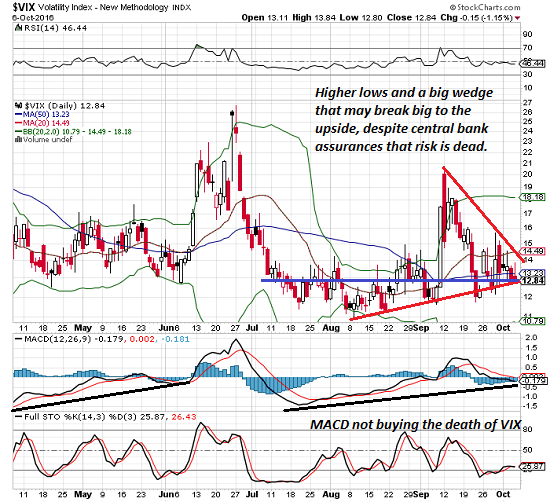Sorry, Central Banks: Risk and Volatility Cannot be Extinguished
October 7, 2016
Central bank market intervention doesn't extinguish risk--it simply transfers it to the system itself.
The unspoken claim of central bank policy is that risk can be extinguished by intervention/manipulation: once the Fed has your back, i.e. is supporting the market, risk disappears, and the easy profits flow to those who buy the dips with supreme confidence in the Fed's ability to magically turn risk-assets into risk-free assets.
Unfortunately for the credulous investors who believe this, risk cannot be extinguished, it can only be transferred to others or to the system itself.
This confidence in central banks raises a pernicious systemic risk: assuming the "100-year flood" can't happen every 6 years or so. I have from time to time highly recommended The Misbehavior of Markets. The author, fractal pioneer Benoit Mandelbrot, explains in simple mathematical ways how Modern Portfolio Theory, i.e. the management of risk, is based on a faulty conception of risk and statistical chance.
In a nutshell: while modern portfolio management is statistically based (all those "standard deviations" you always see referenced in quantitative analyses), the markets behave fractally. Fractals are known as the geometry of chaos, for they describe how seemingly stable systems can quickly, and unpredictably, degrade into chaos.
But as Mandelbrot explains, "100-year floods" actually occur with startling regularity in all markets. Put another way: you cannot disappear all risk with fancy statistical models and credit default swaps, etc., that offload the risk onto others, i.e. counterparties.
In other words, all you're really doing is masking the risk--you're not eliminating it. And in hiding the real risk, you are lulling the market participants into a pernicious choice architecture in which their willingness to take riskier and riskier actions is rewarded and encouraged, while caution is punished.
This is the Paradox of Risk: by masking risk behind assurances that the Fed has your back, the Federal Reserve is encouraging unwary investors to increase their exposure to risk without even being aware of the dangers.
I covered the perverse consequences of believing risk can be "managed away to near-zero" in my book An Unconventional Guide to Investing in Troubled Times.
This is how you get a total systemic collapse of the entire choice architecture. And by this I mean not just the financial markets, but the backstop provided by central banks.
In a system that is now highly correlated to central bank policies, the idea that some counterparty will cover your losses is illusory. This is magical thinking: that when the system implodes, the counterparties will magically escape the highly correlated collapse. And if they don't, well, the central banks will make good the losses. What's $47 trillion in notational derivatives exposure between friends?
This is a second Paradox of Risk: central bank intervention provides the illusion that systemic risk has been extinguished, but in pushing all asset classes into correlation, they've eliminated cross-asset hedging.
Central banks have declared war on volatility as a means of managing perception of risk. Since volatility reflects risk perception, the Fed keeps pummeling volatility (VIX) in the hopes that by killing VIX, it will instill confidence in market players that risk has been sedated and dumped in the East River.
Technically, there is some evidence that VIX is only playing dead. VIX has been notching higher lows and has traced out a wedge that threatens to break big up or down. As for breaking down, VIX is already in the 12s, so a breakdown to the 10s is not much of a fall. But the upside is much more expansive: 20, 30, 40 even 50 are all on the table despite the assurances of the Fed that volatility has been sedated and disappeared, never to be seen again.

Central bank market intervention doesn't extinguish risk--it simply transfers it to the system itself. In effect, manipulating VIX and the market only pushes risk into zones the Fed can't control with its usual bag of tricks (having proxies sell volatility and buy SPX futures contracts and options) and usual propaganda.
So by all means, go on believing the Fed has our backs. That works until all the risk
that's been offloaded into the system itself takes down everything the Fed doesn't control,
and all the "safe" portfolios blow up.
Join me in offering solutions by
becoming
a $1/month patron of my work via patreon.com.
My new book is #8 on Kindle short reads -> politics and social science: Why Our Status Quo Failed and Is Beyond Reform ($3.95 Kindle ebook, $8.95 print edition) For more, please visit the book's website.
NOTE: Contributions/subscriptions are acknowledged in the order received. Your name and email remain confidential and will not be given to any other individual, company or agency.
|
Thank you, Michael F. ($10/month), for your outrageously generous pledge to this site-- I am greatly honored by your steadfast support and readership. |

Discover why Iím looking to retire in a SE Asia luxury resort for $1,200/month. |